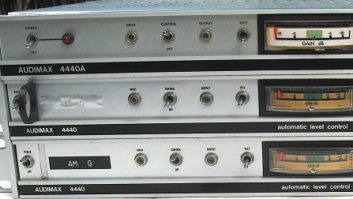Audimax Memories
I came across Charles S. Fitch’s Milestonesarticle about the CBS Audimax and Volumax as the result of a Web search.
I worked at radio stations that used both the AM and FM stereo versions and had some experience working on the guts of the FM stereo Audimax and Volumax. I don’t recall the part numbers but, judging by your article, they were probably the 400 series. Over time, I made small modifications to both.
Your article says the AM Volumax had a “nifty but primitive asymmetrical diode clipper scheme.” It was much more than that. It was an on-the-fly polarity flipper that would invert the polarity whenever the incoming asymmetry was greater in the negative direction. Thus, even before any clipping, the waveform was optimized to achieve higher positive modulation.

Ready after refurbishment to go back into service for another 30 years, this FM Volumax 410 will go to a new FM for Esperance, N.Y. CBS photos courtesy Buc Fitch The stereo Audimax had the odd quirk that the quantity it strove to maintain constant was the volume of the L+R sum voltage. In FM stereo broadcasting, this is not exactly ideal, because a Left-only or Right-only source causes the Audimax to raise the gain 6 dB higher than a source that is more centered between Left and Right.
But the transmitter’s modulation depends on the higher of Left or Right, regardless of whether the other channel is doing the same thing or not.
As a result, if you set your transmitter levels with typical audio signals, the modulation tended to go off the scale whenever a Left-only or Right-only source comes along. Granted that doesn’t happen too often, but when it does, the results are not exactly pleasant.
And it gets really bad if you have an errant source with the channels out-of-phase, such that L+R is very low. The Audimax cranks the gain up to max, and either your modulation meter pegs, or your peak limiter has to work overtime to keep it from doing so!
You don’t want to keep transmitting with channels out-of-phase, but the misbehavior of the Audimax only made the problem worse by making you go off looking for where the distortion is coming from, and why the peak flasher is stuck ON.

The classic 400 series layout, with PCBs in a card cage configuration interconnected with cable harnesses. So I modified our Audimax so that the coupling cable between the two channels just ganged the two gain control voltages together (after studying the schematic to make sure it was OK and would do the right thing). This had the effect of adjusting gain based on the higher of Left or Right. Problem solved.
And then there was the Volumax. The FM Volumax was designed with a pre-emphasis circuit in the input stage, and the entire rest of the circuitry operated on the pre-emphasized audio, all the way out past the peak clipping diodes. Then at the output, they had a passive de-emphasis circuit.
CBS Labs recommended disabling the de-emphasis circuit as well as the pre-emphasis circuit in your transmitter, since the two are complementary and it didn’t exactly make sense to do both. That way the Volumax had more direct control on the audio that was being applied to the modulator.
Unfortunately, the Volumax’s pre-emphasis network in the first stage was a little lacking. It was down a few dB by 15 kHz from the prescribed curve.
While this was within the FCC’s limits on the 75 μ pre-emphasis curve, it was only barely so, and any further deviations anywhere in your system (from the mic preamp to the control board output to the STL to the 15 kHz low-pass filters) could easily put you out of spec for meeting Proof of Performance.
I think the Volumax’s de-emphasis network also deviated from the ideal 75 μ curve by the same amount, so that when you had both of them in place, the Volumax appeared relatively “flat.”
But if you disabled their de-emphasis, which meant you were using their pre-emphasis as the pre-emphasis for your FM station, it was not so good.
So again I modified ours, adding a few small capacitors at strategic locations in their wonderful balanced circuitry, to bring the response up at 15 kHz. That did the trick, and I was rather proud of having what was probably the only FM Volumax (at that time) with a nearly ideal frequency response.
Unfortunately, the station was vandalized a few years later, and the bandits made off with our specially modified Volumax, along with an ancient scope that wasn’t worth much.
But all that was ages ago.
Andy Ingraham
Acton, Mass.
Antennas, Inside-Out
Dear Mr. O’Neal, I was interested to read your story about the “inside-out” FM antenna installation for the former WTOP(FM) — now WHUR(FM) — at 40th and Brandywine Streets N.W. here in Washington (Feb. 1).
You asked if readers knew of any other “inside-out” installations. There is in fact another one, about five blocks away at WTTG(TV), Fox Channel 5. There is an analog Channel 5 antenna installed inside the tower. It was actually put to use about three years ago when WTTG removed its top-mounted analog antenna to install its new DTV antenna to serve WTTG(DT) Channel 36 and WDCA(DT) Channel 35.
A new top-mounted analog 5 antenna was installed above the analog 35/36 DTV antenna; it was simply turned off in June.
Jim Manning
VP Technology
The Classic Soul Experience
Washington
James O’Neal contacted the WTTG engineering department to ask about the report of an inside-mounted television transmitting antenna. The station did have an old RCA three-bay batwing mounted inside the tower for backup or emergency use. It was used only once, for about a month, during the station’s transition to digital and full-power UHF operations. Transmitter power had to be backed off due to a high VSWR condition produced by the tower lattice.
Five Seconds? No Thanks
In his Jan. 1 article “Discover the Power in Just :05,” Rod Schwartz states, “The Radio Advertising Bureau also reported on the success that some stations were having with what they called ‘eight-word ads.'”
The important word is “some.” The application of five-second ads is not something the majority of stations will endorse, for many reasons.
I have been in radio as an accountant, general manager and owner of a standalone radio station for 44 years. Never in my entire career have I surrendered to five-second ads.
The listener might belch or sneeze, and miss the message completely.
The listener might go to the refrigerator and miss the five-second ad.
The listener may have to pick up a phone that is ringing, or answer the door, and not have the joy of hearing a five-second ad on the radio.
The slightest interruption to listening can cause the listener to not hear the five-second ad.
In all my years in radio I have never sold a five-second ad to be heard on my station; and I am quite successful with 30- and 60-second ads — in addition to live programs of 30 and 60 minutes, even several-hour duration depending on the topic, especially those of major interest to my station’s listeners.
I seriously doubt that the number of stations air predominately five-second commercials, increasing ratings in Arbitron’s research.
My station is located in a metro market. Maybe this has something to do with its success.
Mike Petrizzo
General Manager & Owner
KCOH(AM)
Houston
Rod Schwartz replies:
Mike, thanks for taking the time to respond.
I’ve never suggested that a five-second commercial is equivalent to a :30 or :60, as one might infer from your comment about “surrendering” to short ads. No need to view it as an “either/or” proposition; I see it as “both/and.”
I believe short ads can coexist with longer ones, if they accomplish the advertiser’s intended purpose. Hopefully a station’s entire audience would not simultaneously sneeze at the exact moment of the advertiser’s brief message, certainly not every time it aired!
The main issue still boils down to the message. If I can say in five seconds what needs to be said, why take longer to do it? Better to buy additional frequency.
We’ve all heard plenty of cliché-ridden :30s and :60s that say nothing of value to us, going in one ear and out the other, even when we’re not sneezing or raiding the fridge.
I don’t see that market size makes a bit of difference as to the applicability or effectiveness of short ads. You’re in Houston, a sizable market. WGN is in Chicago; it was then, and remains to this day, one of America’s great radio success stories. Running five-second ads certainly didn’t seem to hurt their billing or ratings.
You’re probably right about the majority of radio stations today not “endorsing” five-second ads, perhaps mainly because most can’t find a way to fit them in. Satellite-delivered formats and widespread syndication have taken away a great deal of flexibility in this regard, for better or worse.
Love your passion for radio, Mike. Thanks again for taking time to write. Fight the good fight!
PRSS Correction
An article previewing NAB Show sessions misstated the current timetable for the rollout of a next-generation PRSS system (March 24, page 33).
It incorrectly stated that deployment would start this summer. New receivers are being designed and tested now but are to begin shipping in mid-2011, with a goal of converting to the next system in 2012.










